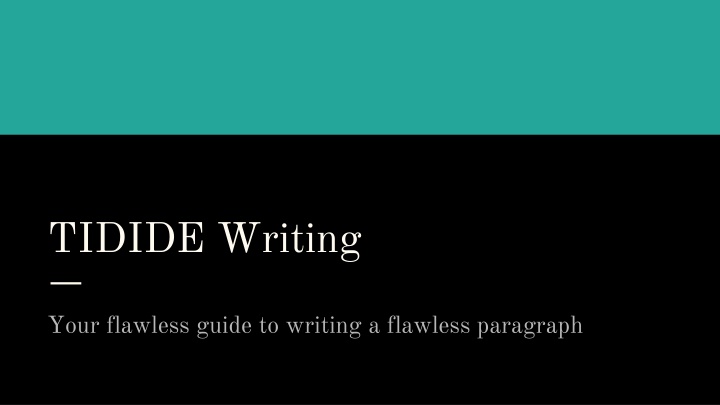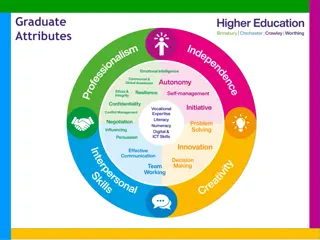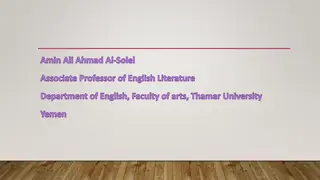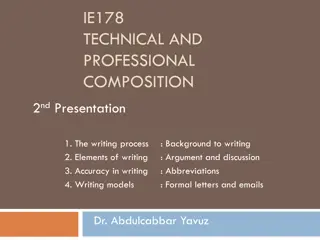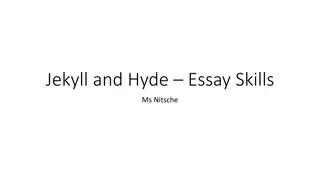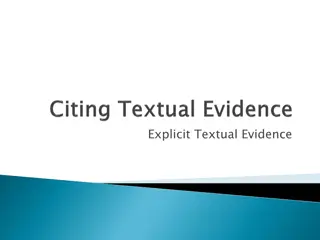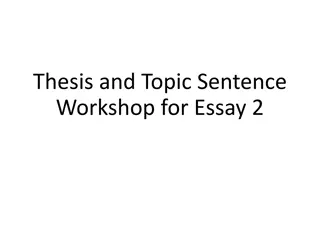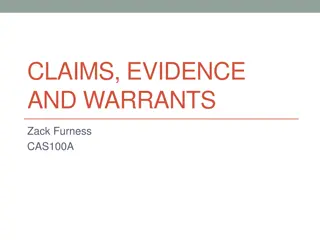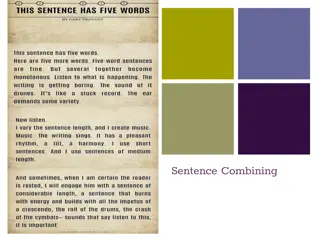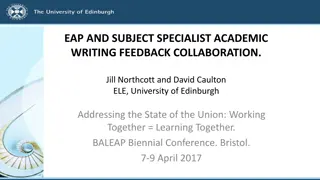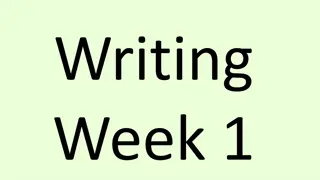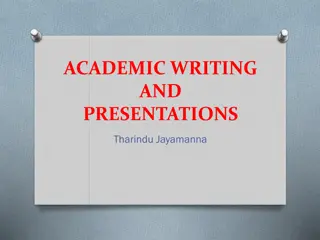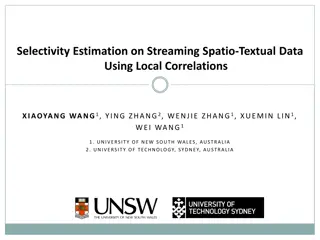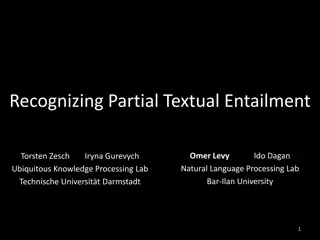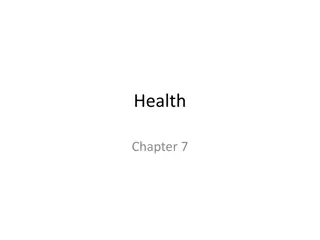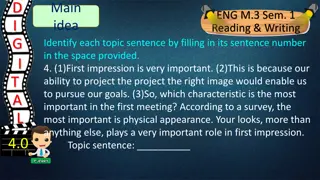Mastering Topic Sentences and Textual Evidence in Academic Writing
Learn how to craft effective topic sentences for your paragraphs, serving as mini-theses and providing a clear roadmap for your writing. Understand the importance of inference and textual evidence to support your ideas with relevant quotes and facts. Enhance your academic writing skills by mastering the art of incorporating evidence seamlessly into your paragraphs.
Download Presentation

Please find below an Image/Link to download the presentation.
The content on the website is provided AS IS for your information and personal use only. It may not be sold, licensed, or shared on other websites without obtaining consent from the author.If you encounter any issues during the download, it is possible that the publisher has removed the file from their server.
You are allowed to download the files provided on this website for personal or commercial use, subject to the condition that they are used lawfully. All files are the property of their respective owners.
The content on the website is provided AS IS for your information and personal use only. It may not be sold, licensed, or shared on other websites without obtaining consent from the author.
E N D
Presentation Transcript
TIDIDE Writing Your flawless guide to writing a flawless paragraph
T- TOPIC SENTENCE If a thesis is a road map to a paper, then a topic sentence is a guide to a paragraph. Therefore, you should think of topic sentences as kinds of mini-theses, organizing and enabling the development of each paragraph in a paper. Use specific language in your topic sentences and avoid making broad, sweeping generalizations (BE SPECIFIC) Vague Topic Sentence: Public schools are great. Stronger Topic Sentence: Public schools do as well academically as private schools, according to statistics.
T- TOPIC SENTENCE The purposes of a topic sentence: 1.To support an essay s thesis statement 2.To unify the a paragraph with a general sense of organization 3.To present to the audience the subject to be discussed Topic sentences do not have evidence (a quote). These are all your words. Topic sentences include an INFERENCE (remember: an educated guess).
T- TOPIC SENTENCE Cool. But what is an inference? An inference is something that you think is true based on information that you have. An inference is NOT directly written in the text. To make an inference, we use evidence from the text and our prior knowledge. Sometimes we have to read between the lines. Authors don t always tell us everything. We need to use textual evidence and prior knowledge to understand the text better.
T- TOPIC SENTENCE State your idea: State the idea you had about the text (if you are responding to a specific question, be sure your idea restates the question). THIS IS YOUR TOPIC SENTENCE. Our Example:
I- Important Evidence When we have ideas about what we read, we need to cite textual evidence to support our ideas. (WORD-FOR-WORD QUOTES) When we read, we often are asked to answer questions or express our ideas about the text. In order to let people know we aren t making stuff up, we use textual evidence to support our opinions or answers. Remember, in literature, your answer is always right, if you can defend the answer with textual evidence.
I- Important Evidence When you are embedding textual evidence, it means that you are incorporating a quote, statistic, or fact directly into the text of a paragraph. Textual evidence is not randomly added to the text of a paragraph. The paragraph is actually constructed around the supporting evidence and serves to describe the evidence and how it connects to the student s thesis statement. Wrong: A dog shows loyalty to its owner by following commands. Cats kill between 1.4 billion and 3.7 billion birds every year in the United States alone, a new report concludes. Dogs are quick to learn the tricks given by their owners.
I- Important Evidence Better, but weird: A dog shows loyalty to its owner by following commands, while cats do not. In the article, Cats Hate Birds by Tom Tigerson, Tigerson argues that cats, on the other hand, refuse their owners commands by doing reckless acts that go against the humans wishes, such as murder. In fact, Cats kill between 1.4 billion and 3.7 billion birds every year. This statistic proves that cats are unloyal. However, dogs are quick to learn the tricks given by their owners This is a stretch, but do you see where I m coming from?
I- Important Evidence Good Embedding Example: How does Holden feel about his childhood? Holden feels that his childhood was miserable. In fact, before he reveals any other information about himself, he guesses that the reader will be interested in his "lousy childhood" (Salinger 1). The first page emphasizes that Holden views his early years negatively therefore, he avoids discussing that time in his life.
I- Important Evidence How do you go about embedding supporting evidence into a paragraph? 1.Use a brief phrase to introduce the supporting evidence. The brief phrase is a sentence that describes the supporting evidence. It may include where the evidence came from, and/or who created it. Examples: In the first paragraph, _____ The author says... The text states... The text describes For example... The author explains...
I- Important Evidence How do you go about embedding supporting evidence into a paragraph? 2. Insert the quote, statistic, or fact that you are using as supporting evidence. Incorporate your supporting evidence in such a way that your paragraphs do not sound awkward or forced. In order to avoid plagiarism, you need to CITE your evidence. You do this by: 1.Putting quotes around the word-for-word quotation 2.Following the quote with a parenthetical citation (usually author s last name and page number) i. BLAH BLAH BLAH (Smolko 7).
D- Detailed Explanation You made your claim/inference in the topic sentence and you found evidence from the text to support it. NOW, you must write about the connection between your inference and the quote. Why did you pick that quote? How does that evidence relate to your topic sentence? Why? How? What do you mean/ see? Go further! Here comes your analysis.
D- Detailed Explanation Explain the Evidence: Explain how the quote(s) or paraphrase(s) you pointed out supports your idea. Sentence starters: This shows... This is because... This means... This reveals... This illustrates... This highlights the difference between...
D- Detailed Explanation This critical stage is often the most difficult for many students. There are two types of writing: Descriptive writing and analytical writing. Descriptive writing answers the "who," "what," "where," and "how" questions. It often tends to summarize the text. Analytical writing, however, answers to the "why" question. When you consider the question, "Why is this point important?", it pushes you beyond mere description/ summary into ideas that are convincing, argumentative, and defend a position. Remember, write as if the audience has already read the text you are talking about. Never summarize, you are past this point.
D- Detailed Explanation What do I even analyze? For literary analysis, common areas to explore in a text include: Identifying common themes, repetitions, and patterns. Categorizing elements, tone (the emotion you get from a text), and narrative style (point of view, stream-of-consciousness) Highlighting characterization (indirect), setting, and foreshadowing. Labeling character types (archetypes), symbols, and metaphors. So the purpose of a D sentence is to interpret meaning, dive deeper in a text, reveal something (symbols & such), or show something that is not obvious to the readers.
Transition After your T, I, and D sentence, you need a transitional word or phrase. Why? This establishes flow in between your pieces of textual evidence so things don t sound choppy or random. Examples: In addition, Also, In the same fashion/ manner/ way, Second, Equally Important, Again, Equally, Moreover, However, Likewise, Additionally, Furthermore,
E- Ending Sentence E Sentences are baby conclusion paragraphs. You should seize the conclusion as an analyzing opportunity to provide your own opinion and reflection about your understanding/processing of the text. This answers the question, So what? In one sentence, summarize the evidence and its role in supporting your inference. Example: Through the evidence, Odysseus tone suggests his growing impatience with his disobeying men by displaying a feeling of betrayal.
Imaginary Cat Article- Meow Cats kill between 1.4 billion and 3.7 billion birds every year in the United States alone, a new report concludes. That s nearly a billion more birds at least than estimated by some previous studies, Peter Marra told Science News. This research scientist, who works at the Smithsonian Conservation Biology Institute in Washington, D.C., led the new study. Any long-term solution will be controversial. Some people propose catching wild cats and neutering them, which means performing minor surgery to make them unable to reproduce. That won t make them kill fewer animals. But it will slow the increase in number of these natural-born killers. Other people have proposed catching and killing feral cats. from page 4 of Lydia Shumaker s article
Question What is the author s purpose and how does she achieve that purpose?
TIDIDE Example The author s purpose is to make people aware that cats killing birds has become a problem and that any solution to the problem will be controversial. In the first paragraph, the author points out that, Cats kill between 1.4 billion and 3.7 billion every year (Shumaker 4). The author s use of that statistic catches a reader s eye because of the shocking numbers, which illustrates the gravity of the issue. Then, in the second paragraph, the author says that there are two controversial ways to solve the problem, by either catching wild cats and performing surgery on them so they cannot reproduce or catching and killing them (4). The author is demonstrating that the possible solutions are controversial because most people probably would not like the idea of cats being caught in order to either operate on them or kill them. By startling the reader with statistics and presenting two very grim solutions, the author calls attention to the problem yet offers little hope.
